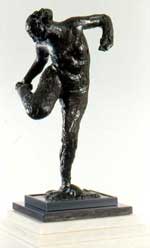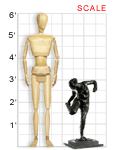VAM galleries including this work:
The Owensboro Museum of Fine Art | Go Figure || VAM Home
Edgar Degas (French, 1834-1917)
DANSEUSE REGARDANT LA PLANTE DE SON PIED DROIT (The Dancer Looking at the Sole of Her Right Foot), late 1800s/early 1900s
Bronze with black patina; 18-3/4" X 10" X 7-3/4"
A Gift of the William T. Stevenson Family
Collection of Owensboro Museum of Fine Art
As a painter, Edgar Degas is famous for his depiction of dancers. This piece reflects an interest in sculpture the artist developed later in life. Degas exhibited only one wax sculpture during his lifetime, the Little Fourteen-Year-Old Dancer with cloth costume, ribbon, and real hair. Apparently viewing them as continual “works in progress,” Degas frequently worked and re-worked the waxes. His process involved using a combination of pigmented wax with a non-drying modeling clay applied over a wire armature that had been filled with cork, rope, sticks, or other found objects. He had only two of the sculptures cast in plaster. After his death, 74 of them, including this one, were cast in bronze. Pressed in the wax, the artist’s fingerprints are visible in the cast bronze, which is the 59th of 74 produced and the 8th of 22 casts.
About the Artist
Hilaire Germaine Edgar Degas was born in Paris in 1834 and studied at the Ecole des Beaux-Arts. Encouraged by avant-garde Parisian artists such as Edouard Manet (1832-1883), Claude Monet (1840-1926), and Pierre Auguste Renoir (1841-1919), he became part of their rebellious group, producing art that defied the conventions of academic tradition. This new generation of artists whose style shocked the world became known as masters of one of the greatest periods in art history: French Impressionism.
“It’s one thing to copy what one sees, but it’s much better to draw what can only be seen in one’s memory. It’s a transformation during which the imagination collaborates with the memory.”
Although Degas never considered himself a true member of the group, he was one of its most active supporters, organizing and exhibiting in all but one of their eight exhibitions. He became a master of several media and took pastel painting to unprecedented heights. The world of theater and dance held a particular fascination for him, and he received his greatest acclaim for his depiction of women, particularly dancers.
In 1880, he developed an interest in sculpture which continued until his death in Paris in 1917. Throughout this period, his eyesight was steadily diminishing, but Degas took his failing sight as an artistic challenge. “It’s one thing to copy what one sees,” he said, “but it’s much better to draw what can only be seen in one’s memory. It’s a transformation during which the imagination collaborates with the memory.... There your recollections and fantasies are freed from the tyranny exerted by nature.”
Classroom Ideas
Discussion: Vocabulary terms relating to this work include Impressionism, oil pastel, and three-dimensional. Do you think Degas’ diminishing eyesight could have contributed to this work’s lack of detail, or do you think the lack of detail was a matter of style? Compare this work to paintings of dancers by Degas. How are they similar and different? What do you think about the quote by Degas?
Activities: Choose a physical activity to be portrayed in sculpture. Build a wire armature for a papier-mâché sculpture, or cover the armature in foil or other material. Create a drawing or painting of the same activity, then compare your experience as an artist in each medium.
Create two works of art, in any medium—one of an object or scene you are looking at now, another of a moment from your memory. Afterward, discuss Degas’ quote.
Links
The ABC Gallery has nearly 120 images of two-dimensional works by Degas.
[www.abcgallery.com/D/degas/degas.html]
The biography of Degas on the Arcadian Galleries site provides interesting facts about his life.
[www.mezzo-mondo.com/arts/mm/degas/degas.html]
Degas in Bronze: The Complete Sculptures documents a 2004 exhibition.
[www.iatwm.com/200407/Degas]
You’ll find links to museums with works by Degas, online image resources,
and articles on Degas in his entry in the Artcyclopedia.
[www.artcyclopedia.com/artists/degas_edgar.html]

